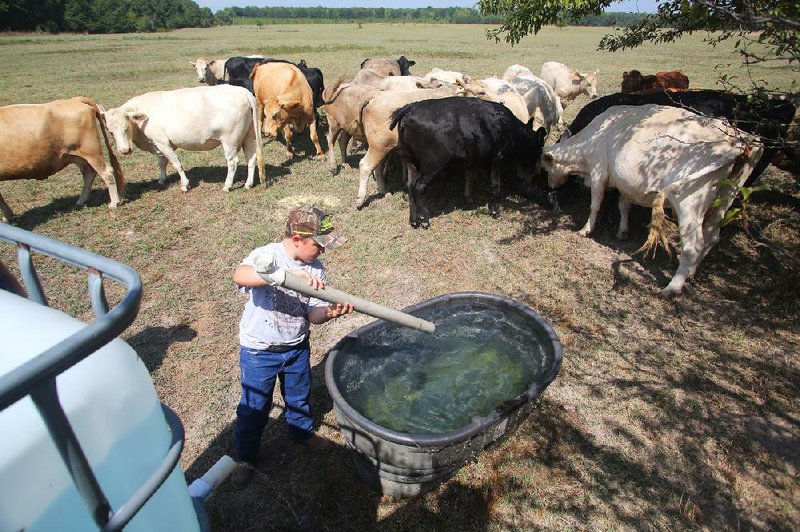LITTLE ROCK — More than half of Arkansas is now listed in the worst category of drought, according to a report released Thursday.
The National Drought Mitigation Center at the University of Nebraska-Lincoln released a report Thursday that said 53.26 percent of Arkansas is now in exceptional drought, up from 44.46 percent at the same time last week.
Central and western Arkansas received between half an inch and an inch of rain Wednesday, but it wasn’t enough to make any significant difference at a time when there’s still a 7-inch rain deficit, said Matthew Clay, a meteorologist at the National Weather Service’s North Little Rock office. He said this week’s rain, if anything, will keep the drought from getting worse, but it won’t alleviate it.
“It certainly didn’t hurt, but we need these two or three times a week, not just once a week,” Clay said. “We really need a lot more rainfall before expecting to improve at all.”
Joe Goudsward, the office’s senior forecaster, said Arkansas should get more rain in the next week as a cold front moves in but not a significant amount.
“It’s August, and August is typically our hottest and driest part of the year. Even after next week, we’re not looking at much of a pattern change,” Goudsward said.
Arkansas businesses that depend on rain have had to adapt.
Lack of rain translates into lack of grass, and Kevin Hicks, a farmer at Hicks’ Family Farm in Lonoke County, said it also has translated into a lack of hay to feed to his cattle. He said he has looked around, and there’s nowhere local that has enough hay for sale to support his farm once what he has on hand runs out.
“The cost of everything is up,” Hicks said.
Mark Rockwell, owner of Rockwell Farms Nursery in Rogers, said he has had to use about 7,000 gallons of water a day this summer. He normally uses between 3,000 and 4,000 gallons to sustain his tree and shrub nursery.
Rockwell said he doesn’t have enough water in his wells to sustain his plants and has had to tap into city water, which has increased his costs significantly.
“The heat has put a lot of stress on our oak trees, no matter how much water we put on them,” Rockwell said. “I’ve been on this farm 26 years, but I’ve been [farming] all my life, and this is the worst I’ve ever seen.”
Some nurseries, like Pense Nursery Inc. in Mountainburg in Northwest Arkansas, have had to settle for smaller harvests this year. Owner Phillip Pense said only about half of the berry and grape plants he planted after May survived because the plants didn’t get enough water to establish root systems. He started using his irrigation system in May this year, which he normally doesn’t do until July.
“When the heat is like it is, if you didn’t get a good start, it just stuns,” Pense said. “If you weren’t able to irrigate this year, you probably aren’t doing very well. You can just about bank on losing half to three-quarters of your crop.”
The irrigation system keeps his business alive — but at a cost. Pense said he spends $500 to $800 a week getting water to his plants. Irrigation doesn’t sustain crops as well as natural rainfall does, he said, but it at least keeps them from dying.
“It’s expensive for sure. Farming is a tough business — sometimes, it’s really good, but the last couple of years it’s been really tough because of the weather,” Pense said. “I just hope it breaks sometime, and we have a couple of easy years. I can remember a few years ago, we didn’t even have to irrigate.”
Also, with the lack of rain, many people are finding thatkeeping lawns green is too expensive and difficult this year, said Mark Fenner, owner of GrassRoots LawnCare in Conway. He said his business has had to cut back on staffing because fewer lawns need mowing.
“We’ve had a lot more skips and cancels. A lot of people are unable to keep up with the watering, and they decide to kind of let their yard go,” Fenner said. “Some of them will pick back up in the fall. We’re hoping we get some rain.”
Because Maumelle Water Management is restricting its customers to watering lawns two hours per day, every other day, it’s left lawn-management companies at a loss.
Horticare owner Buddy Olsen said his chemical division can hardly work in Maumelle because fertilizers require watering in. Also, he said, people in Maumelle aren’t hiring his company to install irrigation systems because they’d be so restricted in using them.
Olsen said that in other parts of central Arkansas, where there aren’t such water restrictions, he’s been busier than usual.
His company maintains a lot of commercial businesses’ lawns. Since many apartment complexes and shops depend on first impressions, they’re willing to pay for green lawns, Olsen said.
“It’s always an emergency. We’re getting a ton of calls to Little Rock. It’s kind of hard to keep up with it all,” Olsen said. “Everybody needs you today because their plants are dying and you can’t get there fast enough.”
Horticare hasn’t had to trim its staffing, but Olsen said the heat has resulted in cutbacks.
“One of the bigger issues is having manpower. Weekends in and weekends out of 105-degree weather really drains on the guys after a while,” he said. “Normally, they’ll work extra days and extra hours, but now they’re trying to get out with 35-hour weeks.”
Although the nursery business is struggling now, Olsen said, he foresees a silver lining. “We’re expecting a good fall, because so many trees and shrubs will need to be replaced.”
Front Section, Pages 1 on 08/10/2012

